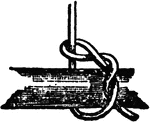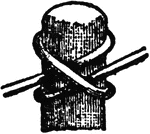Clipart tagged: ‘half-hitch’

Half-Hitch
"Half-Hitch -- Pass the end a of the rope round the standing part b and through the bight." -Britannica,…

Knots and Splices
"Knots and splices include all the various methods of tying, fastening, and joining ropes or cords.…
Knots and Splices
"Knots and splices include all the various methods of tying, fastening, and joining ropes or cords.…
Knots and Splices
"Knots and splices include all the various methods of tying, fastening, and joining ropes or cords.…
Knots and Splices
"Knots and splices include all the various methods of tying, fastening, and joining ropes or cords.…

Knots and Splices
"Knots and splices include all the various methods of tying, fastening, and joining ropes or cords.…

Knots and Splices
"Knots and splices include all the various methods of tying, fastening, and joining ropes or cords.…

Knots and Splices
"Knots and splices include all the various methods of tying, fastening, and joining ropes or cords.…

Knots and Splices
"Knots and splices include all the various methods of tying, fastening, and joining ropes or cords.…

Knots and Splices
"Knots and splices include all the various methods of tying, fastening, and joining ropes or cords.…
Knots and Splices
"Knots and splices include all the various methods of tying, fastening, and joining ropes or cords.…
Knots and Splices
"Knots and splices include all the various methods of tying, fastening, and joining ropes or cords.…
Knots and Splices
"Knots and splices include all the various methods of tying, fastening, and joining ropes or cords.…

Knots and Splices
"Knots and splices include all the various methods of tying, fastening, and joining ropes or cords.…
Knots and Splices
"Knots and splices include all the various methods of tying, fastening, and joining ropes or cords.…
Knots and Splices
"Knots and splices include all the various methods of tying, fastening, and joining ropes or cords.…

Knots and Splices
"Knots and splices include all the various methods of tying, fastening, and joining ropes or cords.…

Knots and Splices
"Knots and splices include all the various methods of tying, fastening, and joining ropes or cords.…

Knots and Splices
"Knots and splices include all the various methods of tying, fastening, and joining ropes or cords.…

Knots and Splices
"Knots and splices include all the various methods of tying, fastening, and joining ropes or cords.…

Knots and Splices
"Knots and splices include all the various methods of tying, fastening, and joining ropes or cords.…

Two Half-Hitches
"Two Half-Hitches -- The half-hitch repeated; this is commonly used, and is capable of resisting to…